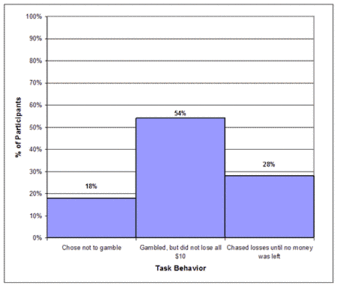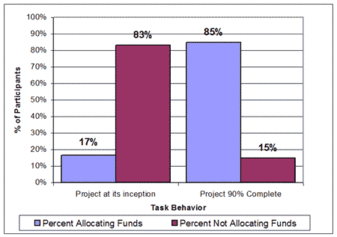The Red Sox have hit the jackpot. Eighty-six years after their last World Series victory, the Cards finally fell their way this season as they pulled off the greatest come-back in Major League history. For most Red Sox fans, this is the pay-off they’ve waited for their entire lives. For others, who already have passed on, the moment came too late. If we study the fans, cheering the Red Sox despite the number of times they have lost, continuing to watch into the 14th inning past 2am because of the 13 innings already invested, believing the Sox have to beat the Yankees this time after the heartbreaking defeat last year, we can’t help but notice the parallel between Red Sox fever and the biases that can lead to excessive gambling. Specifically, Red Sox fans chase their losses with a vengeance – within games, between games, and between seasons. This week, the WAGER uses the boys of October to elucidate two known cognitive biases – chasing losses and the sunk cost effect – and their relationship to excessive gambling.
Chasing Losses
O’Connor and Dickerson (2003) define chasing as “the attempt to recover one’s gambling losses by further gambling” (p. 360). Chasing behavior can occur within- or between-sessions and is often influenced by the gambler’s fallacy – the belief that a series of losses must be followed by a win (see WAGER 4(45)). Using our Red Sox example: despite talk of the curse, Red Sox fans continue to pack the stands, believing that the Sox have to win this year. Their mistake — ignoring the current season’s independence from the string of losing seasons in the past (and in particular, the current postseason’s independence from the string of losing postseasons in the past).1
Evidence has shown that although chasing is not the norm, it is quite common. Breen and Zuckerman (1999) administered a gambling task to 248 male participants who had gambled at least once in their lives. Participants were given $10 and, if they chose, could gamble with that money using a computer program designed by the experimenters to diminish returns across blocks of trials (e.g., 70% of bets won during the first 10 trials, but only 50% won during second 10 trials). Participants could stop gambling at any time. Figure 1 shows that of the 248 participants, 203 (82%) chose to gamble and 70 of those (34% of the gamblers and 28% of all participants) chased their losses extensively, playing until they had no money left.
Figure 1. Percent Chasing Losses on Gambling Task (adapted from Breen & Zuckerman, 1999).
In general, chasing behavior is thought to be most evident after a “near-miss” (see Reid, 1986, for an overview). The idea is that people treat a near-miss as an encouraging sign they are getting close to winning, even in the case of independent chance outcomes. For the Red Sox, last season’s near-miss ALCS loss might explain the increased fervor of their fans this year (but see Note 1). O’Connor and Dickerson (2003) surveyed 221 gamblers (137 electronic gaming machine gamblers and 84 off-course horse-race bettors) about their chasing behavior. When asked about gambling after near-misses, 50% reported that they sometimes or often continued gambling and 24% said they sometimes or often increased their bets. Asked about gambling after heavy losses, 37% said they sometimes or often continued gambling and 17% said they sometimes or often increased their bets. Although this evidence is not conclusive – only the difference between heavy losses and near-misses in continuing to bet reached significance, and the authors did not ask participants whether the near-miss experiences involved heavy or mild losses – it does show that a large proportion of gamblers continue to bet after losses, and a moderate proportion actually increase their bets in response to near-misses.
The Sunk Cost Effect
Arkes and Ayton (1999) define the sunk cost effect as “a maladaptive economic behavior that is manifested in a greater tendency to continue an endeavor once an investment in money, effort, or time has been made” (p. 591). We can view the sunk cost effect as a variant of chasing losses. For both effects, the behavior is the same – continuing to invest despite previous losses – but the sunk cost effect is distinguished by the focus on the resources already invested, not necessarily potential winnings. For our Red Sox fans who continue to watch a game well past their bed time, they do not necessarily believe the Sox will pull off a win in the extra innings. Rather, they feel that they’ve invested so much time and energy in watching the game already, it would be a waste if they turned it off before its completion, even if the prospects of a win are grim.
Evidence for the sunk cost effect was first provided by Arkes and Blumer (1985). In one of their studies, 108 students were told that as the president of an airline company, they had $1 million dollars they could invest in research on an airplane that would use cutting-edge technology, but that their competitor already had developed a better product than what they hoped to develop. Participants then received one of two scenarios. In one scenario (n = 60), the project had not yet been started; in the other scenario (n = 48), the project was 90% complete and they had already invested in it heavily. As can be seen in Figure 2, when no money had been invested in the research, only 17% of participants chose to invest in the project, but when the research was nearly complete, 85% chose to continue to invest in the project, c2(1, N = 108) = 50.6, p < .001.
Figure 2. Percent Investing in a Project as a Function of Sunk Costs (adapted from Arkes & Brumer, 1985).
This WAGER has provided evidence that sunk cost biases and chasing behavior are both common and similar. With respect to gambling research indicates that chasing behavior is a key component of disordered gambling; it is one of DSM-IV’s diagnostic criteria for pathological gambling. O’Connor and Dickerson (2003), in the article described earlier, found correlations above .50 (p < .001; 25+% of variance in one variable accounted for by the other variable) between reported chasing behavior and impaired control (measured by a 12-item self-report scale) and correlations above .30 (p < .01; 9+% of variance in one variable accounted for by the other variable) between reported chasing behavior and gambling expenditure as a proportion of income. Breen and Zuckerman (1999), whose study was also described earlier, found that chasers (those who gambled until all their money was gone) had significantly higher impulsivity scores (measured using the Impulsivity subscale of the Zuckerman-Kuhlman Personality Questionnaire) than other gamblers, t(202) = 2.58, p < .01. Although these findings provide evidence of a relationship between chasing and other variables associated with excessive gambling, they do not provide an explanation for that association. Chasing can be measured and described behaviorally (e.g., increasing bets after losses), but a range of possible cognitive motives and biases might influence that behavior (e,g., the sunk cost bias vs. the gambler’s fallacy). No research has specifically examined the relationship between vulnerability to the sunk cost bias and excessive gambling, much less chasing behavior. Future research ought to examine these relationships, as well as the influence of other cognitive biases on such behavior.
But what about avid Red Sox fans? Didn’t their chasing and persistence pay off? Didn’t they finally hit the jackpot? Some did, some ran out of time, and all evidenced seasonal BoSox disorder – unhealthy preoccupation, distress, and maladaptive behavior during the month of October.
Comments on this article can be addressed to Sarah Nelson.
Notes
1 This analogy breaks down a bit because it can be argued that the current season or game’s performance is not independent of the losses of previous seasons. However, for the Red Sox, this argument would most likely predict continued losses from season to season, not the greater probability of a win. Additionally, postseason performances from season to season most likely are independent.
References
Arkes, H. R., & Ayton, P. (1999). The sunk cost and Concorde Effects: Are humans less rational than lower animals? Psychological Bulletin, 125(5), 591-600.
Arkes, H. R., & Blumer, C. (1985). The psychology of sunk cost. Organizational Behavior & Human Decision Processes, 35(1), 124-140.
Breen, R. B., & Zuckerman, M. (1999). ‘Chasing’ in gambling behavior: Personality and cognitive determinants. Personality & Individual Differences, 27(6), 1097-1111.
O’Connor, J., & Dickerson, M. (2003). Definition and measurement of chasing in off-course betting and gaming machine play. Journal of Gambling Studies, 19(4), 359386.
Reid, R. L. (1986). The psychology of the near miss. Journal of Gambling Behavior, 2(1), 32-39.
Staw, B. M., & Hoang, H. (1995). Sunk costs in the NBA: Why draft order affects playing time and survival in professional basketball. Administrative Science Quarterly, 40, 474-493.






